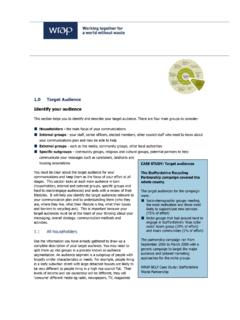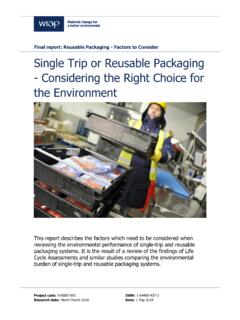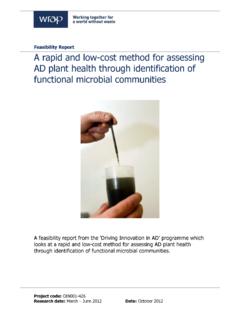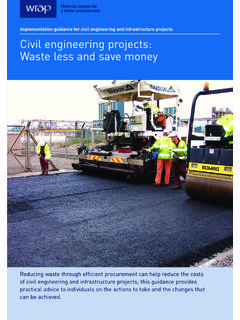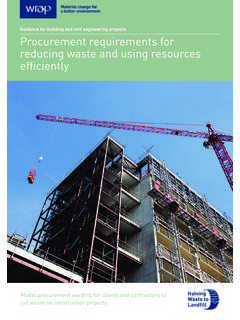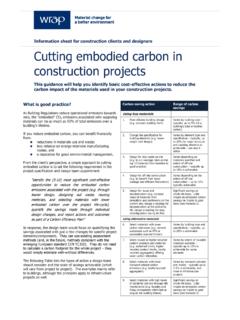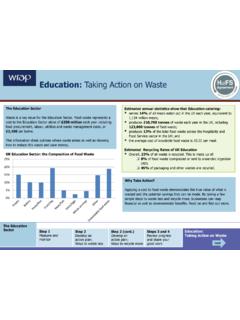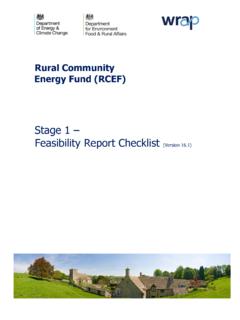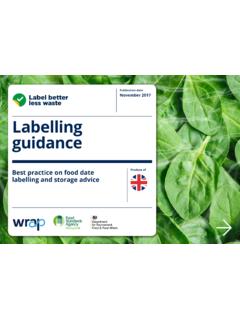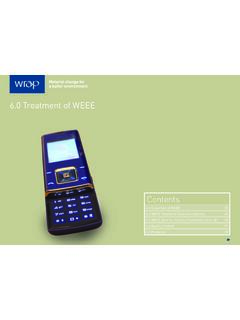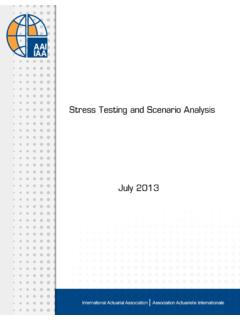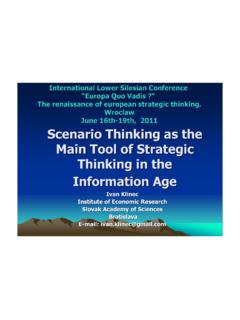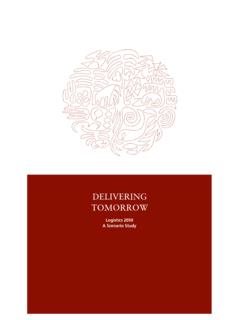Transcription of Evaluating the financial viability and resource ...
1 Evaluating the financial viability and resource implications for new business models in the clothing sector Project code: RNF100-005 Research date: December 2011 April 2012 Date: Feb 2013 WRAP s vision is a world without waste, where resources are used sustainably. We work with businesses, individuals and communities to help them reap the benefits of reducing waste, developing sustainable products and using resources in an efficient way. Find out more at Document reference: [ WRAP, 2006, Report Name (WRAP Project TYR009-19. Report prepared , WRAP] Written by: Martin Buttle, Deeti Vyas & Christopher Spinks Front cover photography: [Clothes on rail Thing Three cc.] While we have tried to make sure this report is accurate, we cannot accept responsibility or be held legally responsible for any loss or damage arising out of or in connection with this information being inaccurate, incomplete or misleading.)
2 This material is copyrighted. You can copy it free of charge as long as the material is accurate and not used in a misleading context. You must identify the source of the material and acknowledge our copyright. You must not use material to endorse or suggest we have endorsed a commercial product or service. For more details please see our terms and conditions on our website at Error! No text of specified style in document. 1 Executive summary Over million tonnes of clothes are consumed and disposed of each year. Of this 31% ends up in landfill (while 48% is re-used, 14% recycled & 7% incinerated)1..A number of reports published in recent years have pointed to the need for economies and businesses to develop sustainable strategies on resource use. In January 2012, the Ellen MacArthur Foundation published Towards the Circular Economy: Economic and business rationale for an accelerated transition2, making the case for a faster adoption of a circular economy, quantifying the economic benefits of circular business models and laying out pathways for action.
3 Furthermore a McKinsey report resource Revolution: Meeting the World s Energy Materials, Foods and Water Needs suggests that businesses are facing a paradigm shift in resource price and volatility3. The need for innovative thinking has been underlined by recent price volatility of raw materials such as cotton, concerns over supply instability, extreme weather events, and wage inflation in South East Asia. With this context in mind, this report explores new, innovative business models of clothing retailing which may be better suited to an economy where businesses and consumers are facing the impact of resource constraints and higher raw material costs models which extend the life of clothes and increase the proportion of garments which are re-used instead of being discarded prematurely.
4 The business models addressed in this report highlight a fraction of the options available to the clothing industry. It is hoped the report will provide a starting point to raise interest and begin discussion about alternative business models. The report does not represent a comprehensive list of all the business models applicable to the clothing industry, nor does it represent the top five options that businesses should explore. Other options or variations on the models in this report, such as collaborations between stakeholders from different parts of the clothing supply chain, may in practice provide greater benefit or be more suitable for implementation. The aim of the research was to assess the commercial viability of five alternative business models, quantify the opportunities to build turnover and deliver a commercially attractive margin and return on investment.
5 The following business models were looked at: 1. Retailers or manufacturers providing repair and upgrading services for their own garments; 2. Retailers providing radical new large-scale leasing services; 3. Retailers providing radical new large-scale services for one-off hire; 4. Retailers offering a re-sale section for pre-owned own-brand garments within their store; and 5. Peer to peer exchange. For each model a first scenario has been developed based on conservative growth assumptions, and a second tipping point scenario, exploring assumptions designed to 1 WRAP Valuing our Clothes 2012 2 Ellen MacArthur Foundation (2012) Towards the Circular Economy: Economic and Business Rationale for an accelerated transition 3 McKinsey (2011), resource Revolution: Meeting the World s Energy Materials, Foods and Water Needs Error!
6 No text of specified style in document. 2 generate sufficient financial performance for the model to be taken up by a retailer. For each scenario, the analysis includes an examination of break-even points where the business model moves into profit and can grow. The following criteria are identified as being key financial measures of success: 2 year pay-back period on capital invested; a positive Return on Capital (RoC), ideally around 15%; and a positive Net Present Value (NPV) of cash flow over a 5 and 10 year period no minimum threshold established. Each business model included in this study has been assessed on its own merit, seeking to show what would be required for it to generate financial performance that would be commercially acceptable to a large-scale retailer. For this purpose, the key financial performance indicators are assessed against the 5 year average profitability performance of a leading high-street clothing retailer and the investment hurdles that they look to achieve when considering investing in a new project.
7 In Model 1, a national retail store offers repair and upgrading service as well as workshops designed to equip, educate and inspire people to take care of their clothes through activities such as repair, and make them last longer. Model 1 has a relatively high cost base and generates low amounts of revenue. Under the conservative scenario it does not provide any payback over a 10 year period. In the tipping point scenario it provides payback in years. Due to a low demand for this type of service, it saves relatively few garments from going to waste. Model 1, as described in this study, is deemed unlikely to be taken up at a large scale by a retailer. However, in recent years, there has been an increase in the number of repair service providers, usually based in local communities, and a potential way forward for a retailer would be to form partnerships with local providers.
8 Model 2 provides large-scale leasing of baby clothes. The initial projections suggest that there is limited consumer demand for leasing of baby clothes. There are advantages, however, to leasing as babies outgrow clothes faster than the clothes wear out. There are also disadvantages babies will dirty and damage clothes in a relatively short space of time. The business model, although marginal from a financial perspective under the conservative scenario, is the most effective from a resource impact perspective with the largest amount of saving of garments going to waste. The assessment suggests that whilst the sustainability and financial case (under the tipping point scenario) can be made for this model, finding the appropriate price points for leasing and lease lifecycle are key to success for a retailer to take this model forward.
9 There are already a number of existing businesses which provide a hiring service for clothes, so it is unsurprising that the financial case stacks up under the achievable assumptions for Model 3. As this model is focused on a small segment of clothing (formal and evening wear) and it has a relatively low displacement ratio when compared with other models, it does not generate the same level of resource savings when compared with the other models. On the basis that the model can succeed financially and it does generate waste, carbon and emissions savings relative to the status quo, Model 3 could be trialled further with willing retailers. Error! No text of specified style in document. 3 In Model 4, a fashion retailer offers an incentive for their customers to return their used garments (bought from that retailer) to a store.
10 The garments are then sent to a central warehouse for sorting, cleaning and re-styling and distributed back to flagship stores carrying the 'pre-owned' collection. Model 4 provides the quickest payback period under both scenarios and is one of the most commercially viable models over the long and short term. This is mainly due to a low cost base and generating resonable profits. It is also one of the most effective at generating waste savings over the long term in both a conservative and tipping point scenario. On the basis of this research, any fashion brand at the forefront of addressing sustainability issues and driving fashion trends, such as the recent increase in anything vintage, would be an ideal candidate for uptake of this model. Model 5, creating an online platform for peer to peer exchange of garments, suffers from the challenge that the business does not own the product being transacted, therefore only received a fraction of the transaction value as income.
